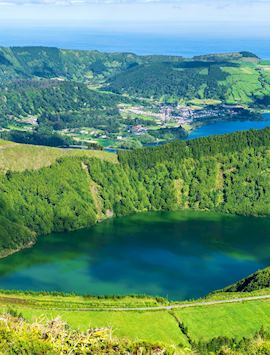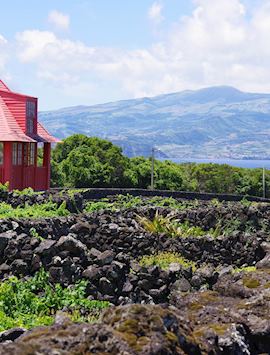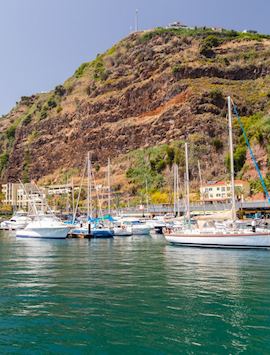By Portugal specialist Cara
Remote and unspoiled, the Azores have been called the Galapagos of the Atlantic or the Hawaii of Europe. While the islands are also excellent destinations for hiking and outdoor adventures, those monikers aren’t quite accurate. Located a bit closer to Portugal than North America, the Azores boast a more diverse array of landscapes than the comparisons suggest.
You can see deep-green fields bounded by bright-blue hydrangeas, conical volcanoes and twin caldera lakes, one azure and one emerald. You can explore all of this either during an in-depth visit to the islands or as an easy addition to a Portugal trip.
Which Azores island should you visit?
São Miguel: the green island
All the islands in the archipelago have chromatic nicknames and São Miguel is known as the green island for its vividly verdant countryside. This is the Azores’ largest island, home to fully half the population.
The capital, Ponta Delgada, has a visually striking historic core. The low buildings are mostly built out of local black volcanic stone that contrasts starkly with the gleaming whitewash of the traditional Portuguese façades. If you’d like to learn more about the capital’s history, we can arrange a guided walking tour that also includes the city’s covered Mercado da Graça.
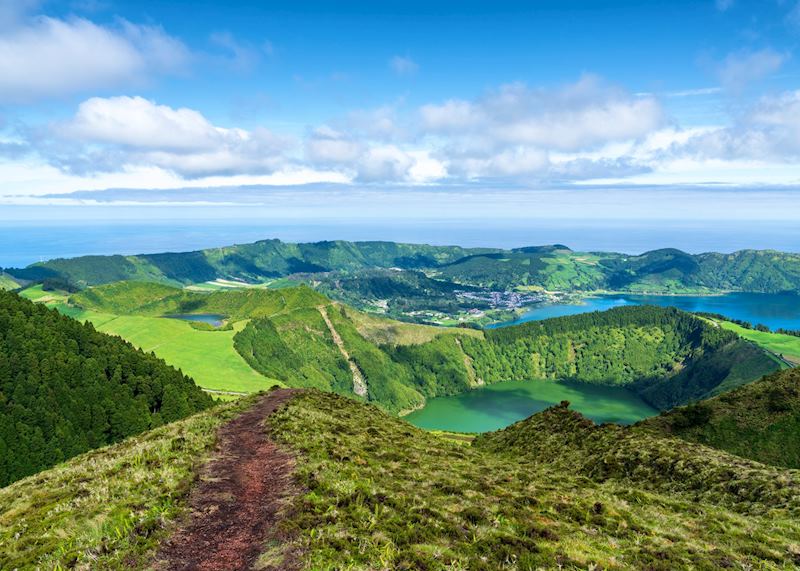
But the island’s real attraction is its pristine landscapes, including Sete Cidades, a forested caldera with twin lakes at the bottom, one green and one blue. It’s just a 40-minute drive northwest of Ponta Delgada, and you can take a half-day guided tour of the area.
My guide to Sete Cidades was Tiago, a tall and irreverent man with short dark hair and a blindingly white smile. He grew up on São Miguel and his passion for his home came through as he led me around.
We started on a bicycle, something I hadn’t done in more than a decade. Despite the saying, it took me a few minutes to get my bearings and Tiago patiently helped me, with only gentle teasing. Then we set off for a path that circled the lake.
As I wobbled along, fumbling with gears, I was grateful that the path around the lake is along mostly flat ground. After a few minutes, though, I could appreciate the lush landscape and compare the different shades of glimmering blue and deep green. Tiago told me some of the myths that have grown up around the area, including sailors’ stories about seven disappearing islands that gave the place its name.
After you’ve circled the lake, you’ll climb into a 4x4 for the drive through the dense forest and up to the rim of the caldera. It’s a tricky route, up narrow switchbacks on a dirt road made uneven by tree roots, and I was glad Tiago was driving instead of me.
The edge of the caldera’s cliffs offers a sweeping view… on a clear day. However, the area is known for its sudden and impenetrable fog and by the time we emerged from the tree cover, all I could see was a misty-white sea of fog that left a sparkle of dewdrops on the bright-green leaves around me. ‘The lakes are still down there,’ Tiago assured me, with a grin.
Where to stay on São Miguel
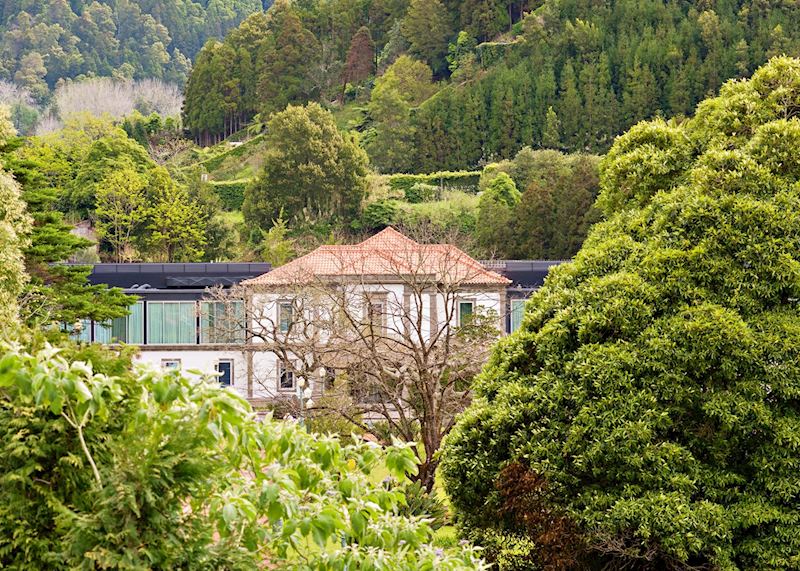
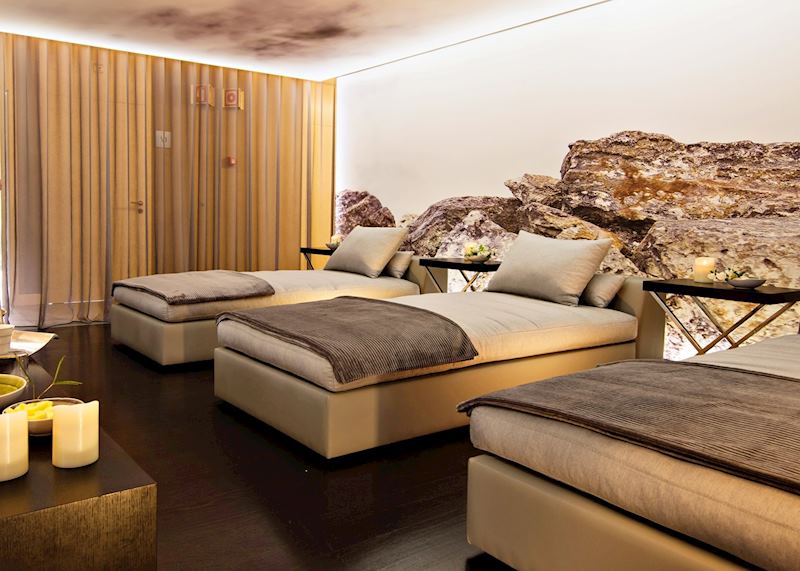
If you’re basing yourself in the capital, I like the Octant Ponta Delgada, which sits on one of the city’s main thoroughfares overlooking the marina — you might even spot a whale or dolphin from your room. You’re a little away from the hubbub of central Ponta Delgada, but can reach its attractions within a 15-minute walk.
A more rural option is Furnas Boutique Hotel, set just outside the quiet village of Furnas, in the east of the island. It has a spa and two pools, plus you’re just a short drive from some of the island’s natural hot springs.
Faial: the blue island
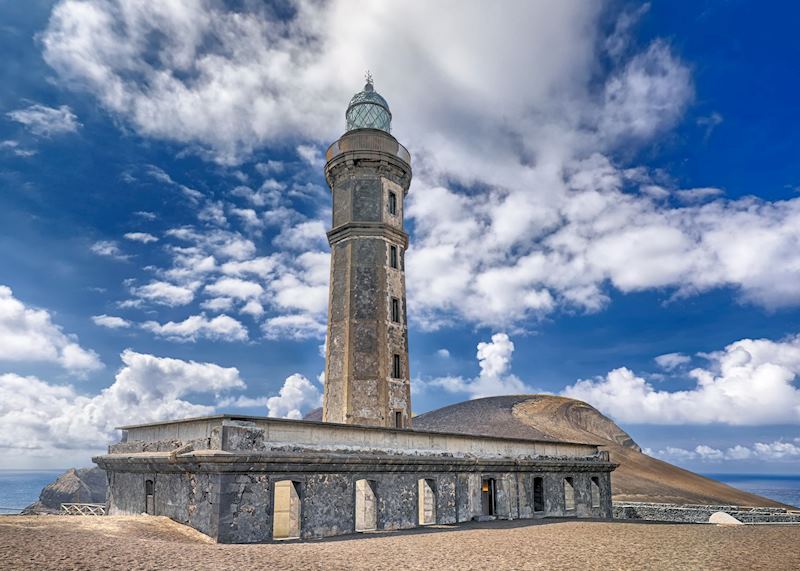
Though the islands now belong to Portugal, they were originally settled by both Portuguese and Flemish pioneers. The Flemish brought with them hydrangeas that still flourish across all the Azores. Faial is blessed with an abundance of the bushes, which bloom vivid shades of cornflower, azure, sapphire and cobalt, giving it the nickname the blue island.
You can visit Faial as a day trip from nearby Pico or spend the night here. The highlight is Capelinhos, one of the world’s youngest volcanoes, which rose from the water offshore in 1957 and erupted irregularly for more than a year, spewing incandescent lava and gray ash into the air.
There were no fatalities, but the closest village was covered in ash and pumice stone. On a guided tour of the island, you’ll see the ridgeline of the roofs where they’re slowly emerging from the hard-packed soil. A half-buried lighthouse today houses the Capelinhos Volcano Interpretation Centre, which explains the geological import of the volcano as well as the social effects that the eruption had.
The tour of the island ends at Peter’s Café Sport, a historic bar in Horta. The original owner was a pillar of the community, delivering letters, matching workers with jobs, and even changing money if you couldn’t get to the banks, a tradition that his descendants maintain to this day.
The main bar is plastered in bright yachting flags, dog-eared postcards and other gifts left by visitors who come to enjoy both the hospitality and the gin and tonics, which are exceptional. Upstairs, you can see the single largest private collection of scrimshaw in the world.
Pico: the gray Island
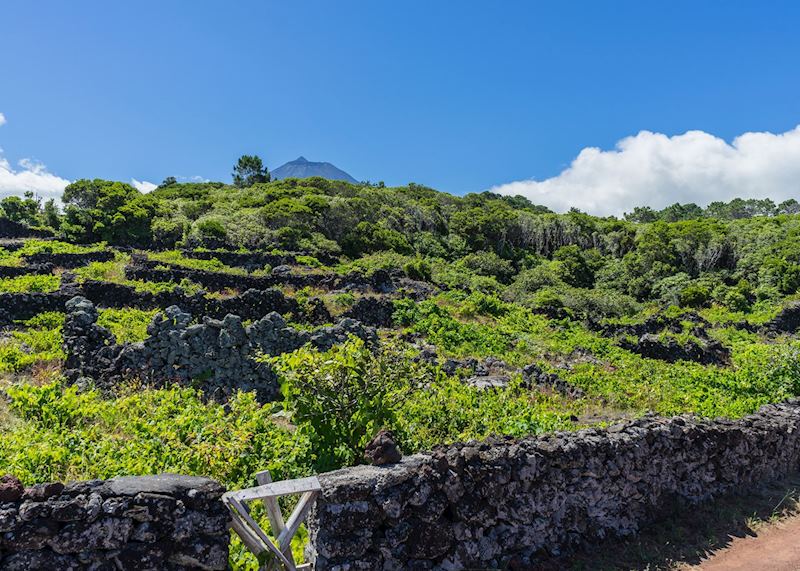
Just a 30-minute ferry ride from Faial, Pico is the gray island, a nod to the volcanic nature of its geology, courtesy of towering Mount Pico. This photogenic stratovolcano is Portugal’s tallest mountain and its many eruptions have covered the island in long twisting ropes of hardened lava flows, known locally as mistérios.
Sicilian monks, who know a thing or two about growing grapes in volcanic soil, were the first to take advantage of the abundant stone and used it to build walls that still provide a thermal buffer for the vineyards. The stone walls not only block ocean winds, they also absorb the heat of the sun during the day and keep the vines warm at night.
Today, the island is known for its wine production and you’ll see vast grids of the omnipresent gray stone covered in dense tangles of grape vines, a landscape that was designated a UNESCO World Heritage Site in 2004.
If you want to sample Pico’s unusual vintages and learn more about its history, I suggest a guided tour of the island that ends at a local wine-growing cooperative that supports the island’s growers.
After a tour of the facility, I got to enjoy a tasting that included a sample of Pico’s premier wine: Frei Gigante. The wine is named after the island’s (probably) apocryphal original monk, an oversized brother named Pedro. Crisp, light and refreshing, it boasted a floral bouquet and notes of citrus.
São Jorge: the brown island
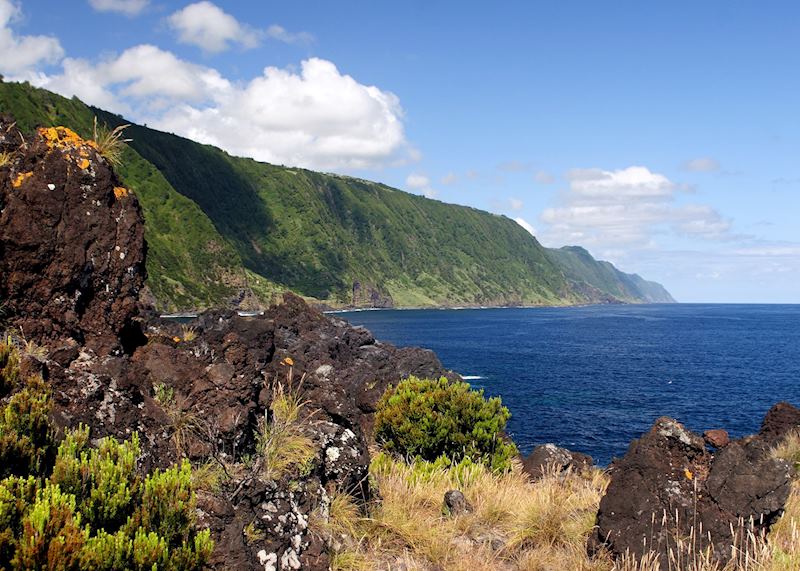
São Jorge is named after the fabled dragon slayer because, if you cock your head to one side and squint a bit, the ridge of volcanoes that runs down the island might look a bit like a dragon’s spiny back. It’s also known as the Brown Island thanks to the high weathered cliffs that soar up, dun brown and russet red, from the blue ocean.
There’s not much to this tiny island, but it’s a pleasantly low-key destination for a day trip from nearby Pico and its high cliffs offer a view of the volcanoes. But I’ll admit that the views aren’t why I visit São Jorge.
For me, it’s all about the cheese.
Cattle outnumber humans two to one on São Jorge. Made happy by the grand buffet of lush pastures, they (the cows, not the people) produce a rich milk that’s the basis of a DOP-protected cheese known as queijo São Jorge.
It’s made in large wheels and features a firm, slightly crumbly texture that’s riddled with tiny holes. In taste, it falls about halfway between a well-aged Cheddar or a very mellow Parmigiano-Reggiano, with that same salty burst of crystalline richness. You can sample variations on the local cheese as part of a guided tour of the island.
Terceira: the purple island
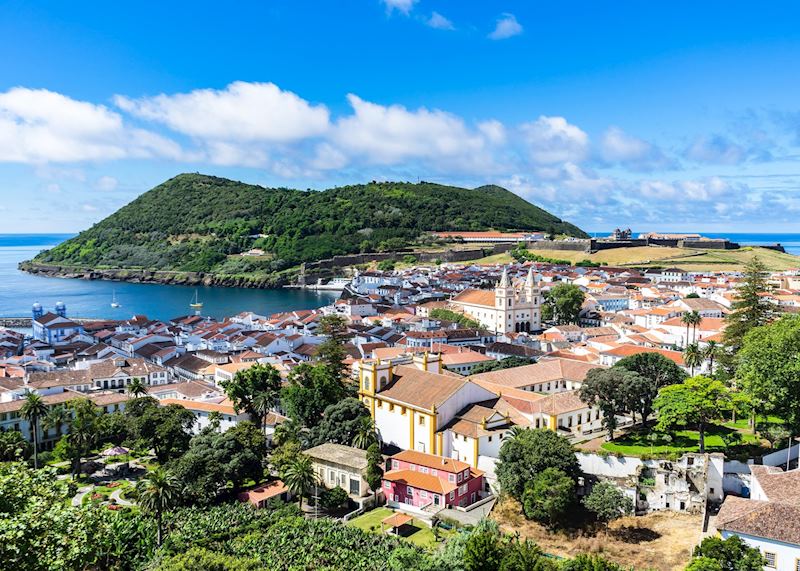
Terceira has two claims to fame: its gloriously lavender sunsets and its residents’ remarkable fortitude. During the Portuguese Civil War in the 1800s, the capital city single-handedly fought off a Miguelist attack, earning the title Angra do Heroísmo — heroic port — from the queen.
For a brief period during the War of the Portuguese Succession, Terceira was the only bastion of Portugal that hadn’t been invaded by Spain. The islanders fought off the Spanish forces by driving herds of half-wild bulls toward the landing parties — the enraged animals trampled and savaged the invaders. To this day, a bull motif is very popular across the island, including a remarkable statue that looks like nothing so much as a fountain of bulls.
Angra do Heroísmo is perhaps the most attractive city on the archipelago, with narrow cobblestone streets twisting between low whitewashed buildings with terracotta-tiled roofs. A walking tour will introduce you to the outsized history of this small city, which has been designated a UNESCO World Heritage Site.
Away from the capital, you can explore the rugged interior of the island on horseback or via a walking tour along the Mistérios Negros. You can also take a boat out onto the often-rough Atlantic to see some of the 28 species of whale and dolphin that live in the waters around the island.
Where to stay on Terceira
For both history and ocean views, I recommend a stay at Pousada Forte Angra do Heroísmo. The hotel is situated in a 16th-century fortress right on the clifftop. While the original building now only has a few remnants remaining, there’s still a real echo of the past here, with the hotel cradled by old stone walls. Despite the quiet, waterfront location, you’re still within walking distance of central Angra.
What to eat in the Azores
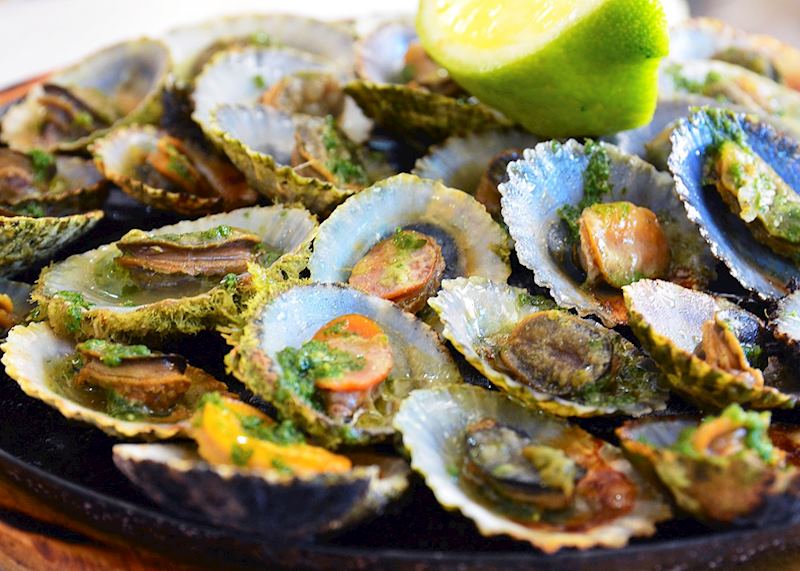
Being surrounded by the vast waters of the Atlantic, it’s unsurprising that seafood is bountiful here. You’ll find fresh tuna as well as swordfish and more obscure species like amberjack. Also on the menu are delicacies like cracas (barnacles) and lapas (limpets, usually served with garlic and butter).
The Azores are also renowned for their cheeses, particularly São Jorge, which produces tangy varieties on a par with parmesan. I heard that around half the cheese found on mainland Portugal is made in the Azores. The fertile soil and mild climate here allow all manner of tropical fruits to grow, and you’ll see pineapple, banana and passionfruit plantations coating the landscape. The oranges I tried here were the sweetest I’ve ever tasted. Coffee beans and tea leaves also grow well here (you won’t find tea growing anywhere else in Europe) so you can try different varieties of the beverages at the islands’ cafés.
On São Miguel, the locals use the island’s volcanic nature to their advantage when cooking. Chefs and local families alike place metal cooking pots in steam holes in the ground, called fumaroles, using the geothermal heat to cook their stew over several hours. You can watch them remove the pots at lunchtime before sitting down to eat the tasty stew, known as cozido, which usually comprises pork, chicken and sausage, along with stewed kale and cabbage in a well-seasoned broth.
Getting to the Azores
Each island has its own airport, though only four have flight connections to mainland Portugal — Pico, Faial, São Miguel and Terceira, and only the latter two operate international flights. You can hop between the islands on short flights, or by ferry (though be aware that the waters can sometimes be rough).
Getting around the Azores
Once on the islands, their compact size makes them easy to drive around, though do prepare for some twisty stretches around the coastlines. We can arrange for private driver-guides to escort you to and from your planned activities, too.
When to go to the Azores
For the best weather, head to the Azores between May and October. However, I recommend avoiding the busiest months of July and August if possible, as sights and attractions become crowded. I prefer visiting during the spring months of April and May, when flowers are in bloom and temperatures begin to pick up but there are fewer people heading to the islands’ shores. October also offers whale watching, making it an excellent time to visit.
Read more about trips to Portugal
Start thinking about your experience. These itineraries are simply suggestions for how you could enjoy some of the same experiences as our specialists. They're just for inspiration, because your trip will be created around your particular tastes.
View All Tours in Portugal

